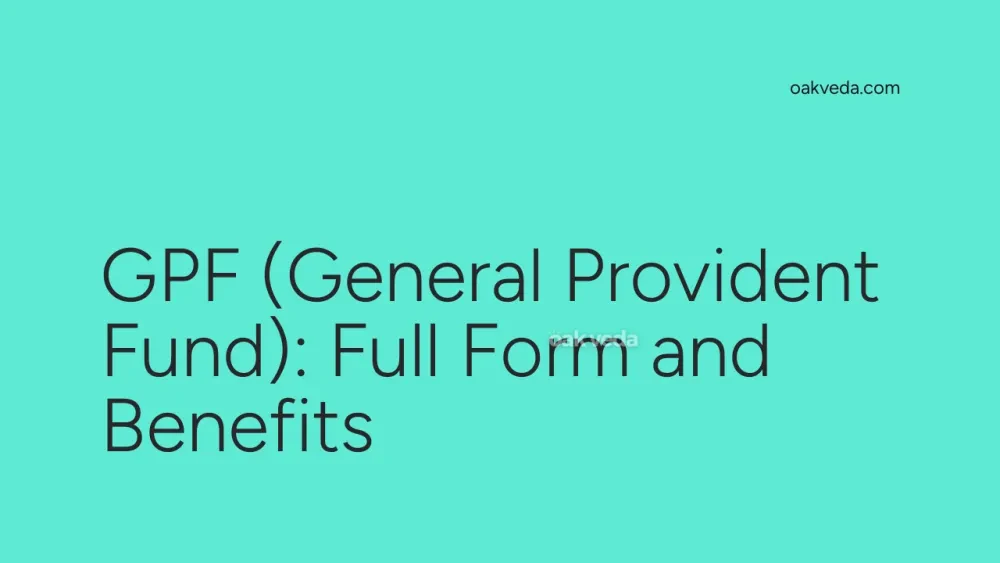
What is the Full Form of GPF?
The full form of GPF is General Provident Fund. This term is widely used in the context of government employment and financial planning in India. GPF is a crucial savings scheme designed specifically for government employees, providing them with a secure way to save for their future.
What is General Provident Fund?
General Provident Fund is a retirement benefit scheme established by the Government of India for its employees. It serves as a long-term savings instrument that allows government workers to set aside a portion of their salary each month. The accumulated funds, along with interest earned, are paid out to the employee upon retirement or superannuation.
Origin and Development of General Provident Fund
The concept of provident funds in India dates back to the colonial era. The General Provident Fund was introduced in the early 20th century as part of the government's efforts to provide financial security to its employees. Over the years, the scheme has evolved to better serve the needs of government workers and adapt to changing economic conditions.
How does General Provident Fund work?
The General Provident Fund operates on a simple yet effective principle:
- Contributions: Government employees contribute a fixed percentage of their monthly salary to their GPF account.
- Interest Accrual: The accumulated funds earn interest at rates determined by the government.
- Withdrawals: Partial withdrawals are allowed under certain circumstances during service.
- Final Payment: The entire balance, including contributions and interest, is paid out upon retirement or superannuation.
Functions of General Provident Fund
The primary functions of the General Provident Fund include:
- Retirement Savings: GPF serves as a mandatory savings scheme for government employees, ensuring they have a financial cushion upon retirement.
- Financial Security: It provides a sense of financial security to government workers and their families.
- Interest Earnings: The scheme allows employees to earn interest on their savings, helping to grow their wealth over time.
- Emergency Fund: GPF can be used as a source of funds during emergencies through partial withdrawals or advances.
Features of General Provident Fund
Some key features of the General Provident Fund include:
- Mandatory Participation: GPF is compulsory for eligible government employees.
- Tax Benefits: Contributions to GPF are eligible for tax deductions under Section 80C of the Income Tax Act.
- Interest Rates: The interest rates on GPF are reviewed and adjusted periodically by the government.
- Nomination Facility: Account holders can nominate beneficiaries to receive the funds in case of their demise.
- Advance Facility: Employees can avail of interest-free advances from their GPF account for specific purposes.
Benefits of General Provident Fund
The General Provident Fund offers several benefits to government employees:
- Forced Savings: GPF encourages disciplined saving habits among government workers.
- Financial Security: It provides a substantial corpus for post-retirement life.
- Tax Advantages: Contributions and interest earned are tax-exempt, offering significant tax benefits.
- Flexible Withdrawals: Partial withdrawals are allowed for specific needs like education, marriage, or medical emergencies.
- Government Backing: The fund is backed by the government, ensuring safety and security of investments.
- Interest-free Advances: Employees can avail of interest-free advances for various purposes.
Limitations or Challenges of General Provident Fund
While GPF offers numerous benefits, it also has some limitations:
- Limited to Government Employees: The scheme is not available to private sector workers.
- Restricted Investment Options: GPF funds are primarily invested in government securities, which may limit potential returns.
- Mandatory Deductions: The compulsory nature of contributions may affect take-home pay for some employees.
- Complex Withdrawal Rules: The rules for partial withdrawals and advances can be complex and restrictive.
Future Developments in General Provident Fund
The government continually reviews and updates the GPF scheme to ensure it remains relevant and beneficial. Some potential future developments may include:
- Digitalization of GPF accounts for easier access and management
- Integration with other government pension schemes
- Expansion of investment options to potentially increase returns
- Simplification of withdrawal and advance rules
FAQs on GPF Full Form
-
Who is eligible for GPF? GPF is available to Indian citizens who are government employees. It is mandatory for those in certain salary brackets.
-
Can private sector employees join GPF? No, GPF is exclusively for government employees. Private sector workers have other options like EPF (Employees' Provident Fund).
-
How is the interest rate on GPF determined? The government reviews and sets the GPF interest rate periodically, typically on a quarterly basis.
-
Is GPF taxable? Contributions to GPF and the interest earned are tax-exempt. The final withdrawal at retirement is also tax-free.
-
Can I withdraw money from GPF before retirement? Partial withdrawals are allowed for specific purposes like education, marriage, or medical emergencies, subject to certain conditions.
-
What happens to GPF if an employee leaves government service? If an employee leaves government service before retirement, they can withdraw the entire GPF balance or transfer it to their new provident fund account if joining another government organization.
In conclusion, the General Provident Fund (GPF) is a vital financial instrument for government employees in India. It provides a secure way to save for retirement while offering tax benefits and the possibility of partial withdrawals for important life events. While it has some limitations, GPF remains an essential part of the financial planning landscape for government workers, helping them build a stable financial future.
You may be interested in:

